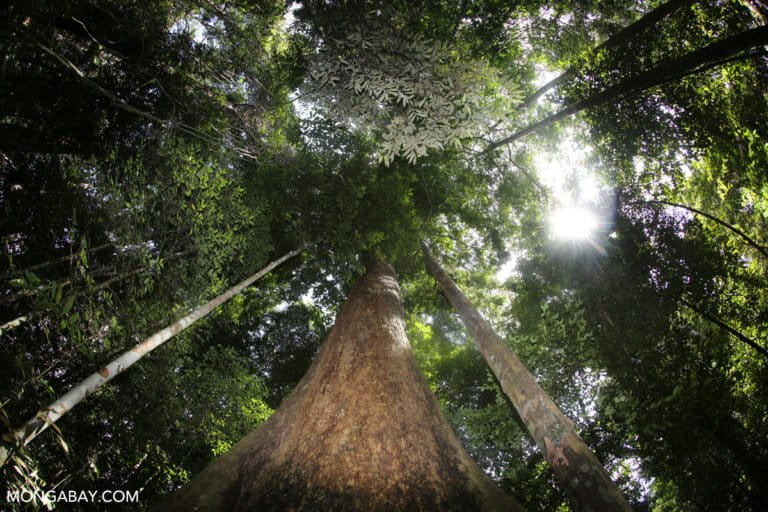- Synchronous mass flowering is one of the most spectacular but least-understood phenomena in Southeast Asia’s tropical rainforests; crucially, scientists know very little about how flowering events might be affected by climate change.
- A new study looking at historical tree flowering in Malaysia has found that between 1976 and 2010, the proportion of flowering and fruiting species decreased as temperatures began to increase through that period.
- They also used models to predict future responses to climate change, finding that a rise of 1.2°C (2.2°F) in average global temperatures by the year 2100 could halve the flowering probability of Dipterocarp trees, an ecologically and economically important tree family in Southeast Asia.
- The researchers say we will likely see shifts in tree species composition in forests as those adapted to climate change are outcompeted by more adaptable species.
When you look at a tropical rainforest, the landscape is usually dominated by shades of green and brown. But every now and then, the trees erupt into flower all at once, festooning the forest canopy with garlands of red, pink and white. Theories abound over which environmental cues trigger the trees to begin their reproductive cycles simultaneously. Drought and low temperatures appear to be key factors in Southeast Asia, where synchronous flowering, or masting, events take place at sporadic intervals that are often years apart. However, very little is known about how climate change will impact such spectacular displays.
Now, a team of scientists using models to predict the flowering of 95 tree species has forecast that even a low-emissions climate scenario could dramatically impact synchronous flowering in an ecologically and economically important tree family.
The models, based on several decades of flowering observations in Peninsular Malaysia, showed that a rise of just 1.2° Celsius (2.2° Fahrenheit) in average global temperatures by the year 2100 could halve the flowering probability of 57% of Dipterocarp tree species in Southeast Asia, according to the team’s findings, published April 21 in Nature Communications Biology.

Dipterocarp trees, named for their two-winged seeds, are among the largest emergent trees in lowland tropical rainforests, and as such, are key components of healthy ecosystems. Several members of the Dipterocarp family are also valuable timber species, and several are included in forest restoration programs due to their high carbon storage potential. Prior studies have shown that in Southeast Asia, the family flowers in response to low-temperature and drought cues.
The team, comprising researchers from Japan and Malaysia, say their findings highlight the vulnerability of some tropical ecosystems to climate change and raise questions over the long-term viability of many trees in a warming world.
“Species that need low temperatures for flowering will be very vulnerable to global warming and at high risk for extinction,” Akiko Satake, a biology professor at Kyushu University in Japan and co-author of the new study, told Mongabay. “Their opportunity to produce offspring will be lost.”
Satake added that trees have evolved a diverse range of reproductive strategies over time, and using low temperatures as a cue for flowering was likely “adaptive” in the past, giving some species the competitive edge over others. However, as global temperatures increase, some species will begin to lose out to those that follow alternative reproductive tactics, she said. As a result, we will likely see shifts in the composition of species in forest ecosystems.

The researchers also looked at historical observations of the flowering and fruiting of 210 tree species (45% of them Dipterocarps) from the arboretum of the Forest Research Institute Malaysia. They found that between 1976 and 2010, the proportion of flowering and fruiting species decreased as global temperatures began to increase, corroborating findings that increasing global temperatures could hamper flowering among many species.
Satake said the findings carry significance for efforts to restore Southeast Asia’s lowland tropical rainforests. Understanding the mechanisms that drive synchronous flowering and fruiting will allow people to predict momentous masting events better, when seeds are plentiful for only a short period of time. In this way, it will be possible to incorporate Dipterocarp species, which are notoriously difficult to cultivate and manage, into nursery programs and tree-planting initiatives.
Next, Satake said she hopes to set up a monitoring network for tree flowering and fruiting throughout Asia so that experts can come together to share their methods, results and data. She said that by accumulating larger data sets, her team will be able to improve their models to predict flowering and fruiting responses across wider regions. “Once we develop a robust model, we can apply [it] to other areas so that we can predict what will happen, for example in Thailand or Borneo, not only in Malaysia.”
Citation:
Numata, S., Yamaguchi, K., Shimizu, M., Sakurai, G., Morimoto, A., Alias, N., … Satake, A. (2022). Impacts of climate change on reproductive phenology in tropical rainforests of Southeast Asia. Nature Communications Biology. doi: 10.1038/s42003-022-03245-8
Carolyn Cowan is a staff writer for Mongabay. Follow her on Twitter @CarolynCowan11
FEEDBACK: Use this form to send a message to the author of this post. If you want to post a public comment, you can do that at the bottom of the page.
